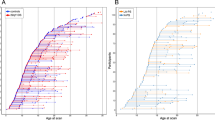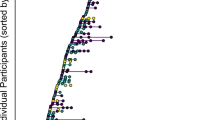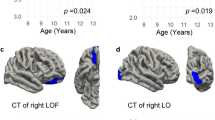Abstract
Disrupted-in-schizophrenia-1 (DISC1), contains two common non-synonymous single-nucleotide polymorphisms (SNPs)—Leu607Phe and Ser704Cys—that modulate (i) facets of DISC1 molecular functioning important for cortical development, (ii) fronto-temporal cortical anatomy in adults and (iii) risk for diverse psychiatric phenotypes that often emerge during childhood and adolescence, and are associated with altered fronto-temporal cortical development. It remains unknown, however, if Leu607Phe and Ser704Cys influence cortical maturation before adulthood, and whether each SNP shows unique or overlapping effects. Therefore, we related genotype at Leu607Phe and Ser704Cys to cortical thickness (CT) in 255 typically developing individuals aged 9–22 years on whom 598 magnetic resonance imaging brain scans had been acquired longitudinally. Rate of cortical thinning varied with DISC1 genotype. Specifically, the rate of cortical thinning was attenuated in Phe-carrier compared with Leu-homozygous groups (in bilateral superior frontal and left angular gyri) and accelerated in Ser-homozygous compared with Cys-carrier groups (in left anterior cingulate and temporal cortices). Both SNPs additively predicted fixed differences in right lateral temporal CT, which were maximal between Phe-carrier/Ser-homozygous (thinnest) vs Leu-homozygous/Cys-carrier (thickest) groups. Leu607Phe and Ser704Cys genotype interacted to predict the rate of cortical thinning in right orbitofrontal, middle temporal and superior parietal cortices, wherein a significantly reduced rate of CT loss was observed in Phe-carrier/Cys-carrier participants only. Our findings argue for further examination of Leu607Phe and Ser704Cys interactions at a molecular level, and suggest that these SNPs might operate (in concert with other genetic and environmental factors) to shape risk for diverse phenotypes by impacting on the early maturation of fronto-temporal cortices.
This is a preview of subscription content, access via your institution
Access options
Subscribe to this journal
Receive 12 print issues and online access
$259.00 per year
only $21.58 per issue
Buy this article
- Purchase on Springer Link
- Instant access to full article PDF
Prices may be subject to local taxes which are calculated during checkout



Similar content being viewed by others
References
Millar JK, Wilson-Annan JC, Anderson S, Christie S, Taylor MS, Semple CA et al. Disruption of two novel genes by a translocation co-segregating with schizophrenia. Hum Mol Genet 2000; 9: 1415–1423.
St Clair D, Blackwood D, Muir W, Carothers A, Walker M, Spowart G et al. Association within a family of a balanced autosomal translocation with major mental illness. Lancet 1990; 336: 13–16.
Chubb JE, Bradshaw NJ, Soares DC, Porteous DJ, Millar JK . The DISC locus in psychiatric illness. Mol Psychiatry 2008; 13: 36–64.
Hodgkinson CA, Goldman D, Jaeger J, Persaud S, Kane JM, Lipsky RH et al. Disrupted in schizophrenia 1 (DISC1): association with schizophrenia, schizoaffective disorder, and bipolar disorder. Am J Hum Genet 2004; 75: 862–872.
Hennah W, Thomson P, McQuillin A, Bass N, Loukola A, Anjorin A et al. DISC1 association, heterogeneity and interplay in schizophrenia and bipolar disorder. Mol Psychiatry 2009; 14: 865–873.
Kilpinen H, Ylisaukko-Oja T, Hennah W, Palo OM, Varilo T, Vanhala R et al. Association of DISC1 with autism and Asperger syndrome. Mol Psychiatry 2008; 13: 187–196.
Williams JM, Beck TF, Pearson DM, Proud MB, Cheung SW, Scott DA . A 1q42 deletion involving DISC1, DISC2, and TSNAX in an autism spectrum disorder. Am J Med Genet A 2009; 149A: 1758–1762.
Cannon TD, Hennah W, van Erp TG, Thompson PM, Lonnqvist J, Huttunen M et al. Association of DISC1/TRAX haplotypes with schizophrenia, reduced prefrontal gray matter, and impaired short- and long-term memory. Arch Gen Psychiatry 2005; 62: 1205–1213.
Hennah W, Tuulio-Henriksson A, Paunio T, Ekelund J, Varilo T, Partonen T et al. A haplotype within the DISC1 gene is associated with visual memory functions in families with a high density of schizophrenia. Mol Psychiatry 2005; 10: 1097–1103.
Callicott JH, Straub RE, Pezawas L, Egan MF, Mattay VS, Hariri AR et al. Variation in DISC1 affects hippocampal structure and function and increases risk for schizophrenia. Proc Natl Acad Sci USA 2005; 102: 8627–8632.
DeRosse P, Hodgkinson CA, Lencz T, Burdick KE, Kane JM, Goldman D et al. Disrupted in schizophrenia 1 genotype and positive symptoms in schizophrenia. Biol Psychiatry 2007; 61: 1208–1210.
Tomppo L, Hennah W, Miettunen J, Jarvelin MR, Veijola J, Ripatti S et al. Association of variants in DISC1 with psychosis-related traits in a large population cohort. Arch Gen Psychiatry 2009; 66: 134–141.
Thomson PA, Harris SE, Starr JM, Whalley LJ, Porteous DJ, Deary IJ . Association between genotype at an exonic SNP in DISC1 and normal cognitive aging. Neurosci Lett 2005; 389: 41–45.
Harris SE, Hennah W, Thomson PA, Luciano M, Starr JM, Porteous DJ et al. Variation in DISC1 is associated with anxiety, depression and emotional stability in elderly women. Mol Psychiatry 2010; 15: 232–234.
Jaaro-Peled H, Hayashi-Takagi A, Seshadri S, Kamiya A, Brandon NJ, Sawa A . Neurodevelopmental mechanisms of schizophrenia: understanding disturbed postnatal brain maturation through neuregulin-1-ErbB4 and DISC1. Trends Neurosci 2009; 32: 485–495.
Harrison PJ, Weinberger DR . Schizophrenia genes, gene expression, and neuropathology: on the matter of their convergence. [References]. Mol Psychiatry 2005; 10: 68.
Bauman ML, Kemper TL . Neuroanatomic observations of the brain in autism: A review and future directions. Int J Dev Neurosci 2005; 23: 183–187.
Haldane M, Frangou S . New insights help define the pathophysiology of bipolar affective disorder: neuroimaging and neuropathology findings. Prog Neuropsychopharmacol Biol Psychiatry 2004; 28: 943–960.
Raznahan A, Toro R, Daly E, Robertson D, Murphy C, Deeley Q et al. Cortical anatomy in autism spectrum disorder: an in vivo MRI study on the effect of age. Cereb Cortex, 2009/10/13 ed, 2009 [e-pub ahead of print].
Giedd JN, Lenroot RK, Shaw P, Lalonde F, Celano M, White S et al. Trajectories of anatomic brain development as a phenotype. Novartis Found Symp 2008; 289: 101–112; discussion 112-108, 193-105.
Gogtay N, Giedd JN, Lusk L, Hayashi KM, Greenstein D, Vaituzis AC et al. Dynamic mapping of human cortical development during childhood through early adulthood. Proc Natl Acad Sci USA 2004; 101: 8174–8179.
Shaw P, Kabani NJ, Lerch JP, Eckstrand K, Lenroot R, Gogtay N et al. Neurodevelopmental trajectories of the human cerebral cortex. J Neurosci 2008; 28: 3586–3594.
Huttenlocher PR . Morphometric study of human cerebral cortex development. Neuropsychologia 1990; 28: 517–527.
Duan X, Chang JH, Ge S, Faulkner RL, Kim JY, Kitabatake Y et al. Disrupted-in-schizophrenia 1 regulates integration of newly generated neurons in the adult brain. Cell 2007; 130: 1146–1158.
Mao Y, Ge X, Frank CL, Madison JM, Koehler AN, Doud MK et al. Disrupted in schizophrenia 1 regulates neuronal progenitor proliferation via modulation of GSK3beta/beta-catenin signaling. Cell 2009; 136: 1017–1031.
Shen S, Lang B, Nakamoto C, Zhang F, Pu J, Kuan SL et al. Schizophrenia-related neural and behavioral phenotypes in transgenic mice expressing truncated Disc1. J Neurosci 2008; 28: 10893–10904.
Kendler KS . Reflections on the relationship between psychiatric genetics and psychiatric nosology. Am J Psychiatry 2006; 163: 1138–1146.
Rastogi A, Zai C, Likhodi O, Kennedy JL, Wong AH . Genetic association and post-mortem brain mRNA analysis of DISC1 and related genes in schizophrenia. Schizophr Res 2009; 114: 39–49.
Hennah W, Varilo T, Kestila M, Paunio T, Arajarvi R, Haukka J et al. Haplotype transmission analysis provides evidence of association for DISC1 to schizophrenia and suggests sex-dependent effects. Hum Mol Genet 2003; 12: 3151–3159.
Szeszko PR, Hodgkinson CA, Robinson DG, Derosse P, Bilder RM, Lencz T et al. DISC1 is associated with prefrontal cortical gray matter and positive symptoms in schizophrenia. Biol Psychol 2008; 79: 103–110.
Schosser A, Gaysina D, Cohen-Woods S, Chow PC, Martucci L, Craddock N et al. Association of DISC1 and TSNAX genes and affective disorders in the depression case-control (DeCC) and bipolar affective case-control (BACCS) studies. Mol Psychiatry 2009/03/04 ed, 2009 [e-pub ahead of print].
Kamiya A, Tan PL, Kubo K, Engelhard C, Ishizuka K, Kubo A et al. Recruitment of PCM1 to the centrosome by the cooperative action of DISC1 and BBS4: a candidate for psychiatric illnesses. Arch Gen Psychiatry 2008; 65: 996–1006.
Eastwood S, Hodgkinson CA, Harrison PJ . DISC-1 Leu607Phe alleles differentially affect centrosomal PCM1 localization and neurotransmitter release. Mol Psychiatry 2009; 14: 556–557.
Nakata K, Lipska BK, Hyde TM, Ye T, Newburn EN, Morita Y et al. DISC1 splice variants are upregulated in schizophrenia and associated with risk polymorphisms. Proc Natl Acad Sci USA 2009; 106: 15873–15878.
Kim HJ, Park HJ, Jung KH, Ban JY, Ra J, Kim JW et al. Association study of polymorphisms between DISC1 and schizophrenia in a Korean population. Neurosci Lett 2008; 430: 60–63.
Hashimoto R, Numakawa T, Ohnishi T, Kumamaru E, Yagasaki Y, Ishimoto T et al. Impact of the DISC1 Ser704Cys polymorphism on risk for major depression, brain morphology and ERK signaling. Hum Mol Genet 2006; 15: 3024–3033.
Palo OM, Antila M, Silander K, Hennah W, Kilpinen H, Soronen P et al. Association of distinct allelic haplotypes of DISC1 with psychotic and bipolar spectrum disorders and with underlying cognitive impairments. Hum Mol Genet 2007; 16: 2517–2528.
Leliveld SR, Hendriks P, Michel M, Sajnani G, Bader V, Trossbach S et al. Oligomer assembly of the C-terminal DISC1 domain (640-854) is controlled by self-association motifs and disease-associated polymorphism S704C. Biochemistry (Mosc) 2009; 48: 7746–7755.
Leliveld SR, Bader V, Hendriks P, Prikulis I, Sajnani G, Requena JR et al. Insolubility of disrupted-in-schizophrenia 1 disrupts oligomer-dependent interactions with nuclear distribution element 1 and is associated with sporadic mental disease. J Neurosci 2008; 28: 3839–3845.
Ozeki Y, Tomoda T, Kleiderlein J, Kamiya A, Bord L, Fujii K et al. Disrupted-in-Schizophrenia-1 (DISC-1): mutant truncation prevents binding to NudE-like (NUDEL) and inhibits neurite outgrowth. Proc Natl Acad Sci USA 2003; 100: 289–294.
Takahashi T, Suzuki M, Tsunoda M, Maeno N, Kawasaki Y, Zhou SY et al. The Disrupted-in-schizophrenia-1 Ser704Cys polymorphism and brain morphology in schizophrenia. Psychiatry Res 2009; 172: 128–135.
Di Giorgio A, Blasi G, Sambataro F, Rampino A, Papazacharias A, Gambi F et al. Association of the SerCys DISC1 polymorphism with human hippocampal formation gray matter and function during memory encoding. Eur J Neurosci 2008; 28: 2129–2136.
Prata DP, Mechelli A, Fu CH, Picchioni M, Kane F, Kalidindi S et al. The DISC1 Ser704Cys polymorphism is associated with prefrontal function in healthy individuals. Mol Psychiatry 2008; 13: 909.
Hariri AR, Weinberger DR . Imaging genomics. Br Med Bull 2003; 65: 259–270.
Lenroot RK, Schmitt JE, Ordaz SJ, Wallace GL, Neale MC, Lerch JP et al. Differences in genetic and environmental influences on the human cerebral cortex associated with development during childhood and adolescence. Hum Brain Mapp 2009; 30: 163–174.
Greenstein D, Lerch J, Shaw P, Clasen L, Giedd J, Gochman P et al. Childhood onset schizophrenia: cortical brain abnormalities as young adults. J Child Psychol Psychiatry 2006; 47: 1003–1012.
Goldman AL, Pezawas L, Mattay VS, Fischl B, Verchinski BA, Chen Q et al. Widespread reductions of cortical thickness in schizophrenia and spectrum disorders and evidence of heritability. Arch Gen Psychiatry 2009; 66: 467–477.
Shaw P, Gornick M, Lerch J, Addington A, Seal J, Greenstein D et al. Polymorphisms of the dopamine d4 receptor, clinical outcome, and cortical structure in attention-deficit/hyperactivity disorder. Arch Gen Psychiatry 2007; 64: 921–931.
Kabani N, Le GG, MacDonald D, Evans AC . Measurement of cortical thickness using an automated 3-D algorithm: a validation study. Neuroimage 2001; 13: 375–380.
Raznahan A, Cutter W, Lalonde F, Robertson D, Daly E, Conway GS et al. Cortical anatomy in human X monosomy. Neuroimage 2010; 49: 2915–2923.
Giedd JN, Blumenthal J, Jeffries NO, Castellanos FX, Liu H, Zijdenbos A et al. Brain development during childhood and adolescence: a longitudinal MRI study. Nat Neurosci 1999; 2: 861–863.
Shaw P, Greenstein D, Lerch J, Clasen L, Lenroot R, Gogtay N et al. Intellectual ability and cortical development in children and adolescents. Nature 2006; 440: 676–679.
Hollingshead AB . Four-Factor Index for Social Status. Yale UP: New Haven, 1975.
Herbeck JT, Gottlieb GS, Wong K, Detels R, Phair JP, Rinaldo CR et al. Fidelity of SNP array genotyping using Epstein Barr virus-transformed B-lymphocyte cell lines: implications for genome-wide association studies. PLoS One 2009; 4: e6915.
Hawkins JR, Khripin Y, Valdes AM, Weaver TA . Miniaturized sealed-tube allele-specific PCR. Hum Mutat 2002; 19: 543–553.
Giedd JN, Clasen LS, Wallace GL, Lenroot RK, Lerch JP, Wells EM et al. XXY (Klinefelter syndrome): a pediatric quantitative brain magnetic resonance imaging case-control study. Pediatrics 2007; 119: e232–e240.
Zijdenbos AP, Forghani R, Evans AC . Automatic ‘pipeline’ analysis of 3-D MRI data for clinical trials: application to multiple sclerosis. IEEE Trans Med Imaging 2002; 21: 1280–1291.
MacDonald D, Kabani N, Avis D, Evans A . Automated 3-D extraction of inner and outer surfaces of cerebral cortex from MRI. Neuroimage 2000; 12: 340–356.
Lerch JP, Evans AC . Cortical thickness analysis examined through power analysis and a population simulation. Neuroimage 2005; 24: 163–173.
Pinheiro J, DM B . Mixed-Effects Models in S and S-PLUS. Springer: New York, 2000.
Genovese CR, Lazar NA, Nichols T . Thresholding of statistical maps in functional neuroimaging using the false discovery rate. Neuroimage 2002; 15: 870–878.
Gogtay N, Ordonez A, Herman DH, Hayashi KM, Greenstein D, Vaituzis C et al. Dynamic mapping of cortical development before and after the onset of pediatric bipolar illness. J Child Psychol Psychiatry 2007; 48: 852–862.
Gogtay N, Greenstein D, Lenane M, Clasen L, Sharp W, Gochman P et al. Cortical brain development in nonpsychotic siblings of patients with childhood-onset schizophrenia. Arch Gen Psychiatry 2007; 64: 772–780.
Peterson BS, Warner V, Bansal R, Zhu H, Hao X, Liu J et al. Cortical thinning in persons at increased familial risk for major depression. Proc Natl Acad Sci USA 2009; 106: 6273–6278.
Brandon NJ, Millar JK, Korth C, Sive H, Singh KK, Sawa A . Understanding the role of DISC1 in psychiatric disease and during normal development. J Neurosci 2009; 29: 12768–12775.
Manji HK, Quiroz JA, Sporn J, Payne JL, Denicoff K, Gray NA et al. Enhancing neuronal plasticity and cellular resilience to develop novel, improved therapeutics for difficult-to-treat depression. Biol Psychiatry 2003; 53: 707–742.
Burdick KE, Kamiya A, Hodgkinson CA, Lencz T, DeRosse P, Ishizuka K et al. Elucidating the relationship between DISC1, NDEL1 and NDE1 and the risk for schizophrenia: evidence of epistasis and competitive binding. Hum Mol Genet 2008; 17: 2462–2473.
Hennah W, Porteous D . The DISC1 pathway modulates expression of neurodevelopmental, synaptogenic and sensory perception genes. PLoS One 2009; 4: e4906.
Camargo LM, Collura V, Rain JC, Mizuguchi K, Hermjakob H, Kerrien S et al. Disrupted in schizophrenia 1 interactome: evidence for the close connectivity of risk genes and a potential synaptic basis for schizophrenia. Mol Psychiatry 2007; 12: 74–86.
Huttenlocher PR, Dabholkar A . Regional differences in synaptogenesis in human cerebral cortex. J Comp Neurol 1997; 387: 167–178.
Sowell ER, Thompson PM, Leonard CM, Welcome SE, Kan E, Toga AW . Longitudinal mapping of cortical thickness and brain growth in normal children. J Neurosci 2004; 24: 8223–8231.
Acknowledgements
This study was funded through the National Institutes of Health, National Institute of Health Intramural Research, and a UK Medical Research Council Clinical Research Training Fellowship (author AR—G0701370). We thank the participants who took part in this study. We are also grateful to the reviewers of this paper for their helpful comments. Dr Raznahan would like to thank Ms Shirley V Rojas for her tireless support on both sides of the laboratory door.
Author information
Authors and Affiliations
Corresponding author
Ethics declarations
Competing interests
The authors declare no conflict of interest.
Additional information
Supplementary Information accompanies the paper on the Molecular Psychiatry website
Supplementary information
Rights and permissions
About this article
Cite this article
Raznahan, A., Lee, Y., Long, R. et al. Common functional polymorphisms of DISC1 and cortical maturation in typically developing children and adolescents. Mol Psychiatry 16, 917–926 (2011). https://doi.org/10.1038/mp.2010.72
Received:
Revised:
Accepted:
Published:
Issue Date:
DOI: https://doi.org/10.1038/mp.2010.72
Keywords
This article is cited by
-
Host–parasite interaction associated with major mental illness
Molecular Psychiatry (2020)
-
Additive sex-specific influence of common non-synonymous DISC1 variants on amygdala, basal ganglia, and white cortical surface area in healthy young adults
Brain Structure and Function (2017)
-
Variations in Disrupted-in-Schizophrenia 1 gene modulate long-term longitudinal differences in cortical thickness in patients with a first-episode of psychosis
Brain Imaging and Behavior (2016)
-
DISC1 Ser704Cys impacts thalamic-prefrontal connectivity
Brain Structure and Function (2015)
-
Role of disrupted in schizophrenia 1 (DISC1) in stress-induced prefrontal cognitive dysfunction
Translational Psychiatry (2013)



